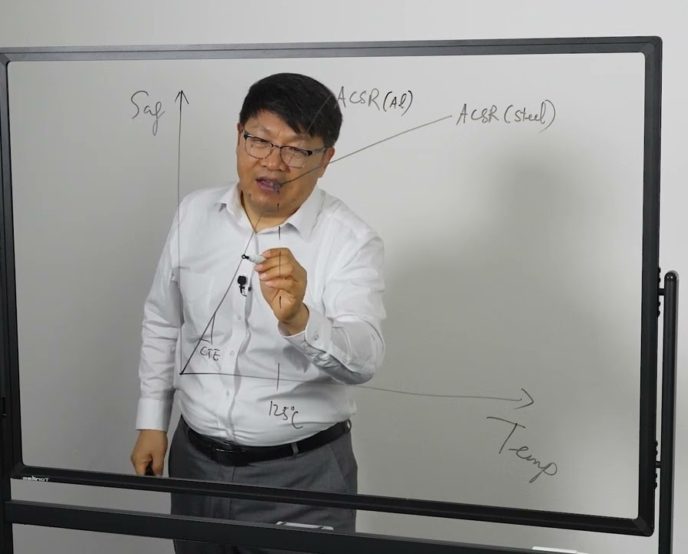Most overhead conductors are bi-component systems made of two distinct materials – typically aluminum strands combined with a steel or composite core. This dual-material construction creates unique thermal-mechanical behaviors that must be understood for proper line design.
The Knee Point Phenomenon
The “knee point” represents the temperature at which the aluminum strands reach zero tension, transferring their mechanical load entirely to the core. This occurs because aluminum has a higher thermal expansion coefficient than core materials, causing it to expand more rapidly with temperature.
Below the knee point, conductor sag increases relatively rapidly, driven by aluminum expansion. Above the knee point, sag behavior is controlled by the core material’s thermal expansion characteristics. The knee point temperature varies by conductor type based on:
- Initial tension in the aluminum strands
- Ratio of aluminum to core material
- Material properties of both components
Conductor Type Comparisons
ACSR (Aluminum Conductor Steel Reinforced):
ACSR exhibits a knee point around 125°C, though this temperature is reached in practice. Below the knee point, sag increases linearly with temperature at a rate determined by aluminum’s thermal expansion coefficient. The theoretical behavior above the knee point would follow steel’s expansion characteristics, but ACSR is typically not operated in this region because the hard-drawn aluminum strands would be permanently damaged.
ACSS (Aluminum Conductor Steel Supported):
ACSS, using fully annealed aluminum, displays a lower knee point temperature than ACSR. This earlier transition occurs because the annealed aluminum carries less mechanical tension. Above the knee point, ACSS can operate at much higher temperatures with relatively high sag behavior controlled by the steel core.
TS AECC (Aluminum Encapsulated Carbon Core):
TS AECC exhibits minimal thermal sag above its knee point due to the extremely low thermal expansion coefficient of its carbon fiber core, resulting in an almost straight sag-temperature line at high temperatures.
ACCC (Aluminum Conductor Composite Core):
ACCC incorporates glass fiber alongside carbon fiber in its core. This hybrid composition results in a thermal expansion coefficient slightly higher than carbon fiber, though still providing excellent thermal sag performance.
ACCR (Aluminum Conductor Composite Reinforced):
ACCR has a relatively high knee point temperature, resulting from the significant tension carried by its high-temperature aluminum alloy strands. Once past the knee point, its composite core provides good thermal sag performance.
Gap-Type Conductors:
These conductors are unique in that their knee point essentially occurs at installation temperature. The aluminum strands are installed with minimal tension, meaning all subsequent thermal sag behavior is governed by the steel core’s properties. While this results in lower initial sag compared to other designs, the steel core’s high thermal expansion leads to significant sag at elevated temperatures.




